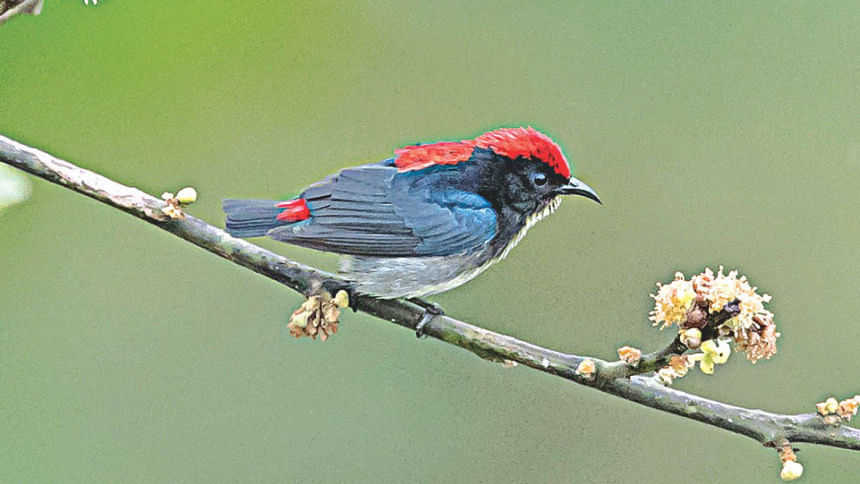Flowerpeckers

At eight centimetres and much smaller than a sparrow it is the smallest bird seen in Bangladesh. Chances are, if you have a large tree near you with a parasitic plant (for example, dhaira, orchid or mistletoe) growing on it, this bird may have been near you. But you probably did not notice it because it is tiny, moves around endlessly and prefers to stay high up near those parasitic plants.
It is the Pale-billed Flowerpecker. The Bengali name is Metethot Fuljhuri.
Flowerpeckers come from the Dicaidae family of songbirds. There are fourty-four species of Flowerpeckers in the world. In Bangladesh we can see six of them, although two are very hard to come by. The family Dicaidae is divided into two genuses: Dicaeum and Prionochilus. All our flowerpeckers are from the Dicaeum genera. Flowerpeckers belonging to the other genera, Prionochilus, are found in Southeast Asia and Australia.
In many ways Flowerpeckers are reminiscent of Sunbirds. They eat nectar, fruits and berries but also take small insects. Like Sunbirds, their tongues curl into a straw that they can use to drink nectar from flowers. Their beaks, however, are shorter than Sunbirds. In general they are stout birds with thick necks. Their flight is swift along a wavy trajectory. If you are watching a flowerpecker in a forest, it is very easy for the eye to lose it when it flies.
I saw my first Pale-billed Flowerpecker in the National Botanical Garden on a vine of dhaira flowers. It was not really a memorable bird, being grey all over, with a pale, pinkish bill. However, it did have a personality: it was fearless and very loud.
It was another two years before I saw the Scarlet-backed Flowerpecker in Rema-Kalenga Wildlife Sanctuary. The male has a wide scarlet stripe running down its black back, looking like the stroke of a paintbrush. Since then I have seen this bird many times. In addition to being extremely vocal it is restless. The female is grey with a smaller, less impressive red bar running down the back of its tail.
I photographed the Orange-bellied Flowerpecker in Sundarban, although at first I mistook it for the chick of some other birds – it was so small. It was in a mixed flock of birds, all feeding off the flowers in an area of ora plants.
The Yellow-bellied Flowerpecker as well as our two rare species, Thick-billed Flowerpecker and Plain Flowerpecker, have eluded me until now.
Flowerpeckers are interesting. They provide a crucial service to the parasitical plants they normally associate with. Eating the flowers and berries of plants such as dhaira and mistletoe, they excrete the seeds on other tall branches so the parasitical plants can grow there.
But what is amazing is this: they excrete within minutes of eating the fruits. Their digestive system allows the seeds to pass through quickly while covering them in a sticky gum. Thus, a seed which is passed as bird dropping does not fall to the ground but sticks to the branch from where a new parasitic plant sprouts and grows.
Such are the mysterious ways of nature.
www.facebook.com/ikabirphotographs or follow ihtishamkabir on Instagram

 For all latest news, follow The Daily Star's Google News channel.
For all latest news, follow The Daily Star's Google News channel. 



Comments